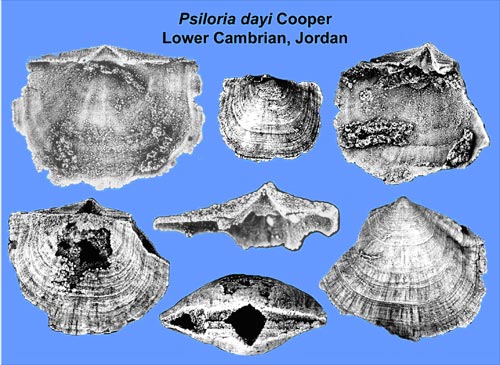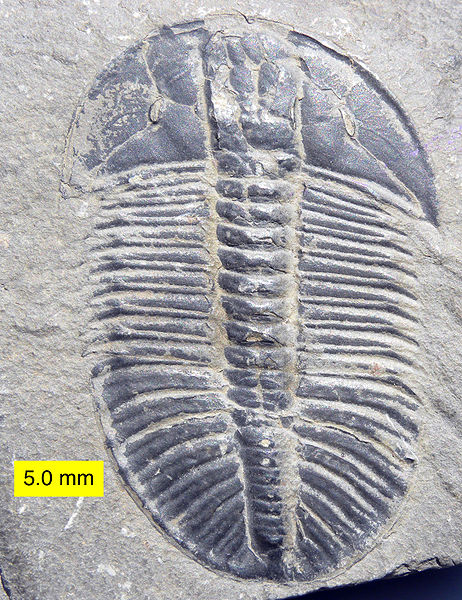[Louis] Agassiz concluded that the fossil record, particularly the record of the explosion of Cambrian animal life, posed an insuperable difficulty for Darwin’s theory.
Meyer continues to describe brachiopods and trilobites.
Here’s what some Cambrian brachs look like.

The trilobite of the Cambrian looks something like this.

http://commons.wikimedia.org/wiki/File:Cambrian_Trilobite_Olenoides_Mt._Stephen.jpg
Meyer says about these two groups (and they are large and varied groups):
The abrupt appearance of such complex anatomical designs presented a challenge to each of the two main parts of Darwin’s theory of evolution.
The two main parts that Meyer refers to here are “Common Descent” and “Natural Selection”.
Meyer continues
The Cambrian fossil evidence [me: “of the time”] represented a significant challenge to Darwin’s claim that natural selection had the capacity to produce novel forms of life.
Now, there were some significant challenges to Darwin’s hypothesis. Because, until the Avery–MacLeod–McCarty experiment (1944) no one really knew how genes were transmitted between organisms. Some researchers today consider this experiment to have actually isolated gene and been the foundation for molecular biology today.
But Darwin didn’t know any of that. All he knew was that offspring tended to look like the parents.
Selection was another significant challenge. What did selection do? How important is it? These are things we still don’t totally understand. Darwin sure didn’t. Yes, he had a nice analogy with artificial selection*.
Finally, I’d like to add that, at some point, Meyer better go into a long and detailed description of fossilization and why the fossil record is both limited and exactly what we expect to see if evolution was indeed the case. All the animals before the Cambrian didn’t have hard parts. No bones, no shells, no teeth for that matter. The squishy stuff that organisms are made from decomposes rapidly except under exceptional conditions. But more on that later. (If anyone needs more detail about what I’m writing and you need it now, please let me know. I don’t mind devoting some posts to education.)
As I continue reading, I love how Meyer misdirects the reader. Look at this passage.
According to Darwin, variations in traits arise randomly. Some variations (such as thicker fleece) might confer advantages in the competition for survival in particular environmental conditions. Thos variations that are heritable and that impart functional or survival advantage will be preserved in the next generation. As nature “selects” these successful variations, the features of a population change.
Darwin conceded that the beneficial variations responsible for permanent change in species are both rare and necessarily modest. Major variations in forms, what later evolutionary biologists would term “macromutations”, inevitably produce deformity and death. Only minor variations meet the test of viability and heritability.
(emphasis in original)
Look at the way Meyer crafts to put the seeds of doubt in the reader. Gosh, Darwin admitted that beneficial variations must be rare and modest. And you know, I’ve been reading up on creationism for a while and about evolution and biology for a lot longer and I’ve never heard the term “macromutation”.
Ah, after a bit of reading on the subject, I guess I can see why Meyer is confused. If one stops reading biological literature about 1940 or so, then one might be under the mistaken impression that a large change, a ‘macromutation’, must be required to generate a large change in the organism. Of course, we know this not to be true. Even a small change in regulatory genes can result in a large change in the organism. For example, a simple mutation might result in an arthropod (like our trilobite above) gaining segments in their body. This is the basis for evolutionary developmental biology. My books link to the right has some books that will help explain that… but we may need to cover it in some detail before we’re done with this review.
Regardless, Darwin didn’t know shit. I’m going to make another prediction (and I hope to be proven wrong): Meyer will not discuss all the current research that shows just how wrong Darwin was about things like this. Darwin’s work predates the most basic understanding of genes, alleles, and DNA by over 100 years.
You know what? Darwin is not the high priest of evolutionary biology. If one casts doubt upon Darwin (the myth that he converted to Christianity before he died or that he owned slaves), it still doesn’t matter that the ideas he had about biology were brilliant. And it certainly doesn’t matter to the millions of peer-reviewed research papers that talk about all the different aspects of evolution that Darwin couldn’t possibly have known anything about.
If Darwin did “concede” that beneficial variations would be ‘rare’ and ‘modest’, then he was wrong. Yes, Darwin was wrong. Beneficial mutations are not rare and they don’t have to be modest.
One last point. Let’s note that Meyer does not define “beneficial mutation” nor does he define “macromutation”. At what level is a mutation beneficial or harmful. Sickle cell anemia remains the most fundamental example of this.
As most everyone knows, sickle cell anemia is a disease caused by a single change of a single nucleotide in the gene that makes hemoglobin. The result is blood cells that are shaped like sickles instead of donuts. They don’t carry oxygen as efficiently and they can get stuck in capillaries causing all kinds of problems. Indeed, if one has two sickle cell alleles (remember everyone has two alleles for all genes… almost), then one can expect to have a short and not pleasant life. One might think that is horrible and certainly a harmful mutation.
And you would be right, unless you lived in an area where mosquitoes carry the parasite that causes malaria. These parasites can live in normal red blood cells, but can’t in the sickle cells. In a place were malaria is present, then having one allele for sickle cell is a beneficial mutation. But only one allele.
So you see with this example, what counts as beneficial and harmful greatly depends on the environment.
I’ve also talked about an experiment in which a harmful mutation was a ‘potentiating’ mutation. The negative mutation was actually required to get a much better effect later on.
Now, I’m willing to give Meyer a chance to correct all the misunderstandings he seems to be promoting here. I’m hoping that this is just a history lesson, but he seems to be going out of his way to promote certain ideas without making sure they are understood to be in historical context.
_______________________________
* I hate using “artificial selection”. Unless one is actually inserting genes, then one can only make do with alleles exist in the animals. “Artificial selection is probably faster and more specific than ‘natural selection’, but they operate the same way. Something external to the animal determines whether it has ‘good genes’ or ‘bad genes’ and determines its likelihood of reproducing. This can be the environment or another organism.
